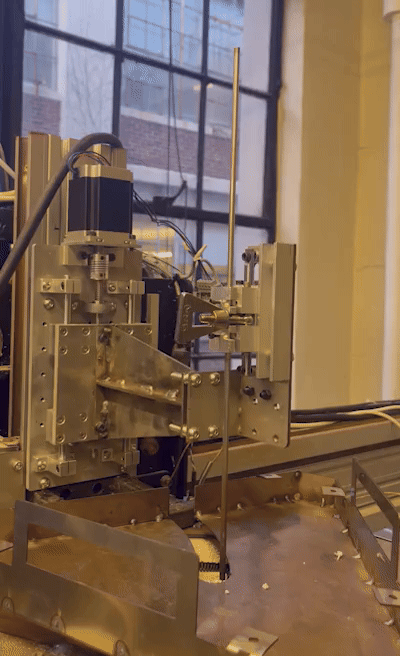
Liquid Metal Printing
Liquid Metal Printing is a metal additive manufacturing process that involves heating metals to melting point and controlling a liquid metal flow from a heated nozzle into a bed of granular material, similar conceptually to something like CNC sand casting. LMP is an alternative to most metal additive manufacturing processes that focus on slower processes of sintering metal powders and instead considers the opportunity for fast, large-scale, coarse resolution, low-cost parts, that can be used as structural components. The methodology also takes advantage of varied feedstocks, which can be scrap materials or previously printed parts, that can be continually remelted and printed into new parts for use.
LMP was originally developed in the Self-Assembly Lab at MIT in 2020 with low melting point alloys, and this further progression of the machine was developed with Zain Karsan, who focused on the process for his MS Thesis at MIT in 2023. The current machine is a custom furnace developed to reach the melting point of aluminum, custom heated nozzles for extrusion control, and a deep bed of glass beads for printing parts that also require travel in the Z axis. All parts printed during this phase of the project have been produced from scrap aluminum waste.
See more about the project in the press here and here, and see Zain Karsan's thesis document here.

00_LMP Printing
.jpg)
00_LMP

00_LMP Stopper Rod Extrusion Control
.jpg)
00_LMP Custom Furnace
.jpg)
00_LMP Melting Stock, photo by Zain Karsan
.jpg)
00_LMP Printed Specimen, photo by Zain Karsan
.jpg)
00_LMP Printed Specimen, photo by Zain Karsan
.jpg)
00_LMP Printed Specimen, photo by Zain Karsan
.jpg)
00_LMP Printed Table Legs by Zain Karsan
.jpg)
00_LMP Printed Table Legs by Zain Karsan